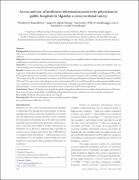| dc.contributor.author | Tumwikirize, Winifred A. | |
| dc.contributor.author | Ogwal-Okeng, Jasper | |
| dc.contributor.author | Vernby, Åsa | |
| dc.contributor.author | Anokbonggo, Willy W. | |
| dc.contributor.author | Gustafsson, Lars L. | |
| dc.contributor.author | Lundborg, Cecilia S. | |
| dc.date.accessioned | 2019-10-31T09:23:36Z | |
| dc.date.available | 2019-10-31T09:23:36Z | |
| dc.date.issued | 2008 | |
| dc.identifier.citation | Tumwikirize, W. A., Ogwal-Okeng, J. W., Vernby, A., Anokbonggo, W. W., Gustafsson, L. L., & Lundborg, C. L. (2008). Access and use of medicines information sources by physicians in public hospitals in Uganda: a cross-sectional survey. African health sciences, 8(4), 220-226. | en_US |
| dc.identifier.uri | https://hdl.handle.net/123456789/77 | |
| dc.description.abstract | Background: Rational and cost-effective prescription of medicines requires up-to-date and readily accessible medicines information.
There are several studies on availability and access to medicines information sources, but have been conducted only in high-income
countries.
Objective: To assess medicines information sources accessed by physicians in public hospitals in Uganda, and physicians’ opinion on
establishment of a medicines information centre in the country.
Methods: A cross-sectional survey including 369 physicians from six district, six regional and two university hospitals. Data was
collected using a semi-structured self-administered questionnaire.
Results Response rate was 91%. This included 31, 136 and 168 physicians from the district, regional and university hospitals,
respectively. In the district hospitals the source of medicines information reported to be most available was colleagues (100%), while
in the regional and university hospitals it was literature from pharmaceutical companies (98%) and hard copy of research publications
(99%) respectively. The most frequently used source in the district and regional hospitals was National Standard Treatment Guideline
(90% and 73% respectively), and colleagues in university hospitals (89%). Accessibility problems with reported available sources
were commonest with research publications in medical journals, both hard copy and through the internet, MIMS, pharmacists and
pharmacologists. Need for a medicines information centre was indicated by 80% of the respondents.
Conclusion: Majority of the physicians in public hospitals in Uganda have limited access to unbiased drug information. Therefore,
there is need to assess the feasibility of establishing a drug information centre, and then assess its use during a trial period.
Key words: Medicines information, physicians, Uganda | en_US |
| dc.language.iso | en | en_US |
| dc.publisher | African Health Sciences | en_US |
| dc.subject | Medicines information | en_US |
| dc.subject | physicians | en_US |
| dc.subject | Uganda | en_US |
| dc.title | Access and use of medicines information sources by physicians in public hospitals in Uganda: a cross-sectional survey | en_US |
| dc.type | Article | en_US |

